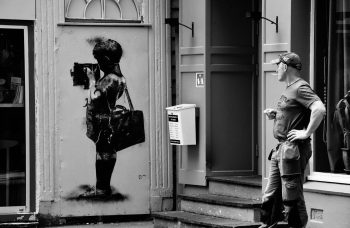There’s a perverse pleasure that comes from taking something apart or seeing exactly how things tick. However, most people are brave enough to disassemble their favourite devices or day-to-day items that, unless you’re an engineer, might not go back together. This, though, is exactly what Toronto-based photographer Todd McLellan has become known for.

Since 2009, McLellan has torn into more devices than most people own in a lifetime. He then photographs the intricate pieces of the gadget, usually in one of two ways: either laid flat in an incredibly orderly and aesthetically pleasing manner, or captured in the chaos of free-fall using super-fast strobe-light technology that produces an equally appealing view. In 2013, he published a book called Things Come Apart, which contained an array of photos from his ongoing series. Images of a broken-down Swiss Army knife or a wood chipper were accompanied by essays by various people involved in process of making such items, from designers to conservators to engineers. Later this year, McLellan will share more of his photography series in an updated version of the book by the same name published by Thames & Hudson. In it, you’ll find 50 deconstructed things, including an Amazon Echo and a 3D printer, both of which are near necessities today but most no one would ever want to tear apart.

Besides producing images that would make the likes of Wes Anderson drool, McLellan’s photographs are a comment on the relationship between goods, consumers, and the environment. It is no secret now that planned obsolescence (the fact that every product is designed with an expiration date) is a mainstay in technology. The old adage that things ‘aren’t made like they used to be’ is true and with devices, the clock ticks down far quicker as new, more advanced, and smarter upgrades push out yesterday’s designs. This means that products are made more cohesive. They aren’t meant to be able to be upgraded or, for that matter, deconstructed.
Take the Amazon Echo that McLellan tinkered with. When he began to fiddle with the device, he recalled thinking ‘“How am I going to get inside this thing?” No visible screws, very new on the market and had never been explored prior, that I knew of. Once the hidden bottom screws were out, it slid open with a bit of friction like you would experience with a boot-hatch hydraulic. Very slick and it felt durable, not that you need that in a tabletop speaker.’ In the end, McLellan was actually able to reassemble the Echo after photographing its pieces.

His project also highlights the number of parts that go into making so many of the items most would find it hard to live without. While some products have massively pared down the number of parts used (a 2002 iPod had only 80 components in comparison to the 370 pieces that made up a Sony Walkman from a few decades before) others haven’t really changed. Seeing each piece of our belongings splayed out reminds us just how much there is in what looks like a singular thing. When we threw out our old cassette players, who thought of all the little parts that would sink into landfills and wind up in the bellies of animals? With all the upgrades, just how much of the globe’s precious minerals and fossil fuels are we using up?
McLellan’s second edition of Things Come Apart will be out in April and is available to pre-order here.





